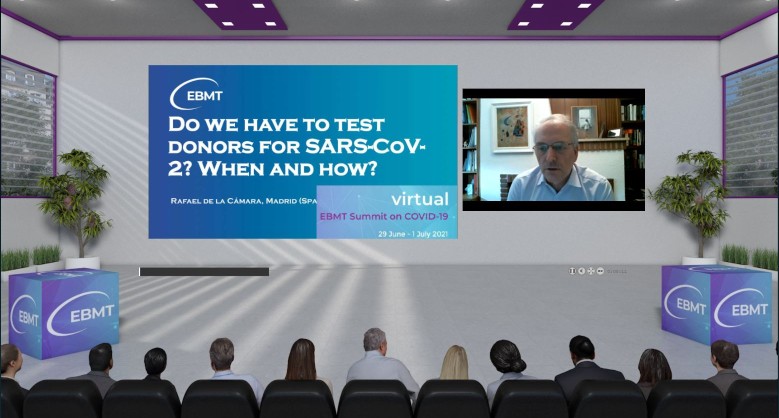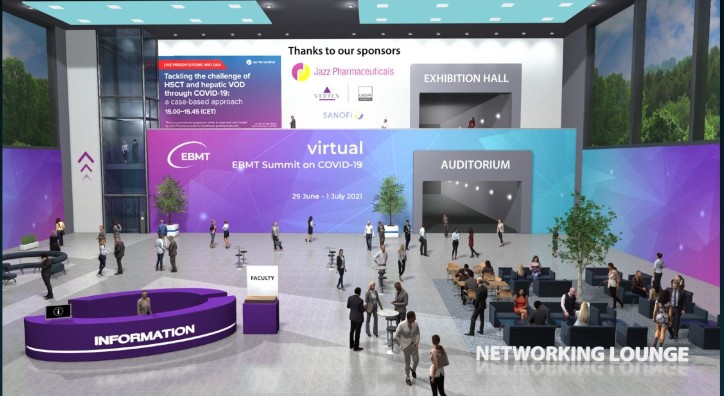
Physicians Programme
The Virus
Summary by Nico Gagelmann, Department of Stem Cell Transplantation, University Medical Center Hamburg-Eppendorf, Hamburg, Germany
The first presentation focused on the geno- and phenotype of the virus itself. Given SARS-CoV-2 is an RNA virus, it is not surprising that the mutation potential is high. We need to consider that every single base mutation is being generated de-novo and transmitted to a new host every day. It is important, however, that there are mutations with different effect i.e. synonymous, non-synonymous, and non-coding. Furthermore, the wide and fast spread of this new virus is due to the intra-host evolution during persistent infection. Current variants of concern, defined as increased transmissibility or detrimental change in COVID-19 epidemiology, increase in virulence or change in clinical disease presentation, or decrease in effectiveness of public health measures are, to date, Alpha (B.1.1.7 from UK), Beta (B.1.351 from South Africa), Gamma (P.1 from Brazil), and Delta (B.1.617.2 from India). Immune evasion is present in the latter 3 variants. Current vaccines are effective in all variants. Current detection mechanismsm include nucleic acid amplification testing, virus isolation by cell culture, direct virus antigen detection, and virus-specific antibodies. Regarding the latter, sensitivity is still a major concern and needs to be handled with caution, especially in immunocompromised hosts. In general, there is great disparity in the way we think about and address different sources of environmental infection. Airborne pathogens and infections such as COVID-19 are addressed fairly weakly in terms of regulation, standards, and building design and operation internationally. For instance, ventilation standards should be developed that explicitly consider health and infection control in their statements of purpose and definition.
Quality in HSCT: Maintaining quality standards during the COVID-19 pandemic
Summary by Nico Gagelmann, Department of Stem Cell Transplantation, University Medical Center Hamburg-Eppendorf, Hamburg, Germany
The full impact of the COVID-19 pandemic on the quality hematopoietic cell transplantation remains uncertain. Direct impact comes from disease-related morbidity and mortality. Indirect impact comes from delayed transplantation. However, there is an open question the quality of outcomes is affected, and if so, even reduced. Clearly, there is psychological and emotional impact on patients, families, and staff. Importantly, the isolation that most hospitals around the world have installed, limiting the opportunity for family visits of patients, have an yet unforeseen impact on the psychological well-being of patients and everyone involved. JACIE is challenged to maintain quality in centres and is looking for new ways of inspections, including remotely. Some centres have frozen allo transplants from matched unrelated donors which has shown to provide similar outcomes. Some locations even had to relocate outpatient services to nearby private hospitals (including apheresis, ECP, marrow harvest, lymphocyte infusions. One example of compromised quality was the need for cancellation of pentamidine treatments and some patients did not do as well on alternative prophylaxis.
Donors’ standards
Summary by Vera Radici, Department of hematology and Bone Marrow Transplantation, Udine, Italy. Currently working at Saint Antoine Hospital, Paris, France
Dr De La Cámara discussed when and how donors should be tested for SARS-COV-2: it is recommended by EBMT to test donor to protect the staff of the pheresis unit, other donors and patients with result available prior to starting the collection procedure.
Dr Calmels then went on to discuss the impact of cryopreservation on HSCT outcomes. The advantages include more convenience for the donor to schedule collection, easier management of poor-mobilizer, ensure timely availability of graft in case of donor unavailability and mitigate risk of unexpected incidents during transport.
Drawbacks of cryopreserved grafts count potential dose-related toxicity of lysed granulocytes and DMSO, reduced viability in case of prolonged transit time and increased costs and risks. Unfortunately 5-10% of URD grafts collected during the pandemic have never been re-infused or because quality of the cryopreserved product was insufficient or because patient’s condition get worse. It is therefore important to inform donor ahead of collection as to the potential risk that collected product may never be used.
For sever aplastic anemia patients cryopreservation must be banner for high rates of graft failure, instead for RD PBSC grafts seems to be safe. For URD PBSC grafts, data of QC before infusion and longer follow-up of patients transplanted during the COVID-19 pandemic are needed.
Dr Worel talked about the influence of the pandemic on handling related donors: vaccination should be prioritized because reduces the virus transmission rate, but the donation should not be delayed due to donor’s vaccination in case the transplant is urgent.
The last presentation by Dr Yang addressed the issue of the unrelated donor based on WMDA recommendations: post-contact or post-infection exclusion period is 14 days and post-vaccine exclusion period depends on the type of COVID-19 vaccine administered:
- vaccine with a virus vector capable of replication: collect no less than 28 days after vaccination.
- vaccine with a virus vector not capable of replication: for HPC(A) commence G-CSF no less than 21 days after, HPC(M) and MNC (A) collect no less than 3 days and where possible 7 days after.
- all other vaccines: G-CSF or collect no less than 3 days and where possible 7 days after.
Instead after donating COVID-19 vaccination may be given after the donor has fully recovered from the donation, in case of HPC (A) avoid vaccines base on a virus vector and use an alternative one to the theoretical risk of immune interaction with G-CSF.

Clinical impact and management in HSCT patients, part I
Summary by Lars Klingen Gjærde, Department of Hematology, Rigshospitalet, Copenhagen University Hospital, Copenhagen, Denmark
This session consisted of three presentations on the impact of the COVID-19 pandemic on the activity in HSCT centers and the clinical outcome in HSCT patients infected with COVID-19.
Prof. Per Ljungman presented the experience of the EBMT:
- First study during 1st wave found that the symptoms of COVID-19 in HSCT patients were like that of the general population: mainly fever, cough, fatigue, and upper respiratory symptoms; however, around a third of patients required oxygen supplementation.
- 25% of patients died with COVID-19 listed as the main cause of death. The survival in allogeneic and autologous transplanted patients were similar. Adults had poorer survival than children and adolescents, and there was a trend towards worse survival in patients infected earlier after transplant.
- In an updated cohort there was a slightly improved survival after COVID-19 infection in the 2nd wave compared to the 1st wave.
Prof. Genovefa Papanicolaou presented the clinical experience at the Memorial Sloan Kettering Cancer Center, USA:
- Early study of outcomes in HSCT patients at MSKCC found that 44% were hospitalized; 18% died.
- COVID-19-related lymphopenia did not impair long-term immune reconstitution.
- CIBMTR study from 1st wave reported a 30-day mortality after COVID-19 infection of approximately 30% in allo- and auto-transplanted patients. Higher age, male sex, and infection earlier after transplant were associated with inferior survival.
- Some HSCT patients had viable virus for up to 2 months after infection.
- The use of cryopreserved products did not impact survival after allogeneic transplantation.
- CIBMTR & BMT CTN are currently conducting a study of vaccine immunogenicity after HSCT and CAR-T treatment. MSKCC are monitoring B- and T-cell responses to vaccination and studying treatment with monoclonal antibodies.
Prof. William YK Hwang presented the experience of The Asia Pacific Blood and Marrow Transplant Group (APBMT):
- A survey of APBMT centers found that the number of allogeneic transplants from a sibling or unrelated donor decreased in 2020, when compared with the trend from 2018 and 2019, while haploidentical and cord blood transplants increased.
Clinical impact and management in HSCT patients, part II
Summary by Nico Gagelmann, Department of Stem Cell Transplantation, University Medical Center Hamburg-Eppendorf, Hamburg, Germany
COVID-19 affects multiple organ systems, including gastrointestinal tract, cardiovascular system, neurology, and thromboembolic events. Cancer patients and those undergoing transplantation or cellular therapy have pre-existing organ injury which may worsen with COVID-19. There are limited data regarding exposures and outcomes after COVID-19 in transplantation and cellular therapy recipients, especially with respect to organ function and damage. One factor that seems to aggregate evidence is continuous and longer viral shedding in patients undergoing transplantation with up to 7 months. As an example to highlight the need for adjusted strategies to prevent nosocomial infections, patients at MD Anderson are routinely tested every 7 days, masks are distributed for all, face shields need to be worn by al patient-facing staff, inpatient unit employees are strongly encouraged to get tested when 2 or more co-workers test positive within 2 weeks, and patient-facing staff on all hematology units change face masks for each patient encounter.
Clinical Impact and Management in HSCT, part III
Summary by Claire Horgan, Paediatric bone marrow transplant and stem cell gene therapy fellow Royal Manchester Children’s Hospital, Manchester, UK
Dina Averbuch began the session by discussing COVID-19 in HSCT in paediatric patients. The majority of paediatric patients affected with COVID will have a mild self-limiting disease, however, a small proportion (<1%) have suffered with a multisystem inflammatory syndrome characterised by life-threatening myocarditis and shock, and this was observed more frequently following HSCT. She discussed the current data available with regard to COVID infection in paediatric HSCT patients which is largely limited to small observational studies. COVID severity in HSCT and onco-haematological patients is higher than in the general population but comparable with that of HSCT children affected with common respiratory viruses. Boys appear to be more severely affected than girls, with the other risk factors for disease severity being obesity and older age. Data from the second wave in the paediatric setting is much less described and it is unclear to conclude whether these observations are the same for different variants.
José Luis Piñana then discussed the epidemiology of other common seasonal respiratory viruses in HSCT during the SARS-COV-2 pandemic and highlighted that the epidemiology of respiratory viruses in allo-SCT recipients mirrors that of the community. Strict preventative measures in the whole population translated into a marked reduction (69.2%) in absolute numbers of common seasonal respiratory virus infections during the SARS-COV2 pandemic in allo-SCT recipients. There was a dramatic fall in absolute numbers of lower respiratory tract disorders (68.1%), common seasonal respiratory virus co-infections (91.7%) and hospital admissions (72.6%) during the pandemic, however, there are significant concerns about the impact of the loss of the annual immunity booster of seasonal respiratory viruses in allo-SCT recipients.
The session concluded with Carolina Garcia-Vidal discussing fungal and bacterial superinfections in COVID patients. She presented data from a number of international studies and emphasised the importance of early and aggressive treatment of patients, highlighting how it significantly reduced mortality associated with the condition.
Clinical Impact and Management in HSCT, part IV
Summary by Nico Gagelmann, Department of Stem Cell Transplantation, University Medical Center Hamburg-Eppendorf, Hamburg, Germany
Large trials such as RECOVERY or RECAP-MAP rapidly provided information for the general population, especially considering the clear benefit of steroids in moderate/severe COVID-19 since inflammatory changes are the main driver of mortality. No data exist separately for the immunocompromised population. There still is an uncertain role of viral versus inflammatory phase in these patients. How shall we treat prolonged infection: with repeated antivirals or with repeated monoclonal antibodies or both?
Currently, there is agreement on systemic corticosteroids for critical COVID-19; awake self-proning to improve oxygenation and high flow nasal oxygen to potentially reduce tracheal intubation; non-invasive ventilation for patients with mixed hypoxemic-hypercapnic respiratory failure; tracheal intubation for poor mentation, hemodynamic instability or severe hypoxemia; closed suction systems; lung protective ventilation; prone ventilation (for 16-24 h per day) to improve oxygenation; neuromuscular blocking agents for patient-ventilator dyssynchrony; avoiding delay in extubation for the risk of reintubation; and similar timing of tracheostomy as in non-COVID-19 patients. There is no agreement on positive end expiratory pressure titration or the choice of personal protective equipment. Convalescent plasma, of no benefit in the general population, may be of benefit in patients who are immunocompromised but more definitive evidence need to be awaited.
Immune response and prevention, part I
Summary by Yuliya Rogacheva, I. P. Pavlov First Saint Petersburg State Medical University, Saint Petersburg, Russia
The session was devoted to the immune response to SARS-CoV-2 infection, one of the key and acute topics of the present time.
Dr. Hans-Gustaf Ljunggren talk addressed the problem of measuring T and B cell response against SARS-CoV-2 and duration of the antiviral immune response. He demonstrated the study. on robust T-cell immunity in convalescent individuals with asymptomatic or mild COVID-19 by Takuya Sekine et al. Authors found reduced frequencies and absolute counts of T-cells. They noted increased co-expression of immune activations markers (CD-38, PD-1, HLA-DR and Ki-67) in both moderate and severe COVID-19. Dr. Hans-Gustaf Ljunggren presented Karolinska KI/K COVID-19 immune atlas aimed to provide a comprehensive overview of the human immune response in COVID-19; the atlas is freely available for scientists, both in academia, in other organizations, and industry.
Dr. Karin Lore demonstrated a study done by her research group in 147 patients with COVID-19 that have been observed for 8 months. They obtained blood and airways samples for IgA, IgG and memory B-cells in period of observation. Scientists concluded that robust plasma IgG and IgA levels are generated during acute disease and follow disease severity; high levels of antigen-specific memory B cells are generated independently of disease severity; antibody levels increase after vaccination with antibody titers exceeding prior levels, especially IgG.
Dr. Michael Boeckh discussed specific aspects of immune response to SARS-CoV-2 in patients after auto- and allo- HSCT. Fatality rate in patients without cancer was significantly smaller than in patients with malignancies during COVID-19 pandemia. Research devoted to immunocompromised patients that can be source of viral variants are important. Optimal time for vaccination after HSCT and duration of protection in these patients remain to be investigated.
Immune response and prevention, part II - Vaccines
Summary by Rosamaria Nitti, Bone Marrow Transplant Unit of the San Raffaele Scientific Institute, Milan, Italy
Prof Charlotte Cordonnier’s first key message was that COVID-19 is a vaccine preventable disease, and vaccination is the way to go to fight this pandemic, as the Israel example shows. What about vaccination in HSCT patients?
Literature is not yet available regarding SARS-CoV2 vaccines in HSCT recipients. Data on SARS-CoV2 vaccines in the general population, however, cannot be easily extrapolated to the immunocompromised individual. Cohorts of frail patients are smaller, and effort is focusing on identifying immune biomarkers of vaccine efficacy (like the anti-Spike RBD antibodies) which could act as surrogate endpoints in clinical studies.
Prof Cordonnier presented interesting data on COVID-19 vaccination in non-transplanted hematology patients, showing better response rates (in terms of antibody titers) among patients with myeloproliferative neoplasms (and CML in particular) compared to patients with multiple myeloma, and very low response rates during treatment with Rituximab, Venetoclax, Ibrutinib.
In hematologic patients, data suggest to avoid postponing the second dose, as the response after the first dose is extremely low (between 4 and 25%) compared to healthy controls.
In studies involving solid-organ transplant (SOT) recipients, the importance of completing the vaccination cycle emerged. Young age, time from transplant, organ function and time of immunosuppressive therapies were associated to response to the vaccine.
Rare issues about safety are observed in the general population, in particular vaccine-induced thrombosis and thrombocytopenia syndrome and capillary leak syndrome (non-replicating viral vector vaccines), and myocarditis and pericarditis (mRNA vaccines); instead, in the smaller immunocompromised cohorts, no specific safety issues have been identified.
The benefit of a third dose is now an important question: a case series by Werbel WA et al. of SOT patients receiving a third vaccine dose (including heterologous schedules) showed striking benefit of a third dose in patients with low antibody titers, while only a fraction of patients without detectable antibody levels responded with a titer increase.
In the absence of prospective studies, EBMT Recommendations for COVID-19 vaccination in HSCT recipients have been a key to guide physician choice during active phases of the pandemic. Nevertheless, given the poor response rates expected after the vaccination in immunocompromised individuals (especially after a single dose), it is fundamental to keep high levels of alert with hygiene measures, PPE and social distancing, and to vaccinate HSCT patients’ family members.
